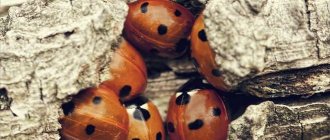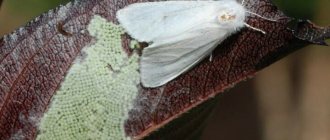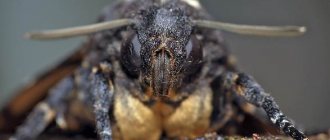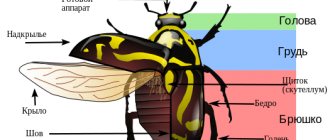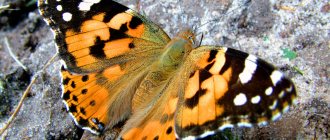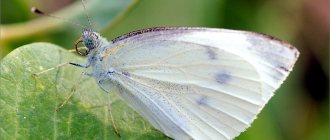Butterfly breeding
The shape and color of the wings are of great importance when breeding butterflies. Some species are sexually dimorphic: males and females differ in appearance, which makes it easier for lepidopterans to find a partner. Other species use pheromones to attract mates. Depending on the species, either males or females can attract a partner in this way. The mating dance is also characteristic of butterflies.
Mating occurs on plant leaves or the ground. It can last from 20 minutes to several hours. By fertilizing a female, the male not only transfers his seed, but also components that are useful during pregnancy. Some species have an interesting feature: after fertilization, a chitinous appendage appears on the female’s abdomen, which eliminates the possibility of repeated mating.
The mating process of the heliconid charitonia is interesting. The female begins to emit pheromones several hours before emerging from the pupa. Males flock to her and begin to fight with each other. The winning male fertilizes the pouch as it emerges from the pupa.
After fertilization, the female lays eggs. This is how butterflies are born. In the tropics, some species can produce up to three generations in one year.
What is metamorphosis and why is it needed?
Metamorphosis, i.e. a life cycle with a series of successive transformations is a very successful acquisition in the struggle for existence. Therefore, it is widespread in nature and is found not only in insects, but also in other living organisms. Metamorphosis allows different stages of the same species to avoid competition among themselves for food and habitat. After all, the larva eats different food and lives in a different place; there is no competition between the larvae and adults. Caterpillars gnaw leaves, adult butterflies calmly feed on flowers - and no one bothers anyone. Through metamorphosis, the same species simultaneously occupies several ecological niches (feeding on both leaves and flowers in the case of butterflies), which also increases the species' chances of survival in a constantly changing environment. After the next change, at least one of the stages will survive, which means the entire species will survive and continue to exist.
Caterpillar
In most cases, butterflies lay eggs on specially selected plants. The small caterpillar hatches from the egg and first eats its shell. Afterwards, it begins to feed on the plant on which it is located. If a butterfly lays eggs on the wrong plant, the caterpillar may refuse to eat and look for more suitable food. At this stage of development, the caterpillar stores nutrients that will serve it for the rest of its life.
The caterpillar eats a lot and grows greatly in size in a short time. The skin of a caterpillar is not elastic, so in order to grow, it molts: it sheds its old skin, which has become narrow. To do this, the caterpillar is attached to the plant with a silk thread. The old skin bursts and the larva crawls out. It takes a little time for the new leather to become strong enough. Afterwards the caterpillar begins to eat again.
On average, a caterpillar molts five times before pupating. Before a butterfly emerges from a caterpillar, its body must undergo an astonishing metamorphosis. When the time comes, the insect is attached to a branch or leaf of a plant with a silk thread. She can hold onto the thread with her hind paws or wrap herself around it crosswise.
Butterfly development: four stages of the life cycle
So, butterflies are insects with complete transformation - they have all four stages of the corresponding life cycle: egg, pupa, caterpillar-larva and imago - an adult insect. Let us consider sequentially the stages of transformation in butterflies.
First, the adult butterfly lays an egg and thereby gives rise to a new life. Depending on the type, eggs can be round, oval, cylindrical, conical, flattened and even bottle-shaped. Eggs differ not only in shape, but also in color (usually they are white with a green tint, but other colors are not so rare - brown, red, blue, etc.).
The eggs are covered with a dense hard shell - the chorion. The embryo located under the chorion is equipped with a supply of nutrients, very similar to the well-known egg yolk. It is by this that the two main life forms of lepidopteran eggs are distinguished. Eggs of the first group are poor in yolk. Those species of butterflies that lay such eggs develop inactive and weak caterpillars. Outwardly, they look like tadpoles - a huge head and a thin, thin body. Caterpillars of such species must begin to feed immediately after emerging from the egg, only after which they acquire fully plump proportions. That is why butterflies of these species lay eggs on a food plant - on leaves, stems or branches. Eggs placed on plants are typical for diurnal butterflies, hawk moths, and many cutworms (especially lancets).
Cabbage butterfly eggs
In other butterflies, eggs are rich in yolk and provide the development of strong and active caterpillars. Having left the egg shell, these caterpillars immediately begin to crawl away and are able to cover sometimes quite significant distances for them before finding suitable food. Therefore, butterflies that lay such eggs do not need to worry too much about their placement - they lay them wherever they need to. Thinworms, for example, scatter eggs on the ground in bulk right on the fly. In addition to slender moths, this method is typical for bagworms, glassworts, many moths, cocoon moths and bear moths.
There are also lepidoptera that try to bury their eggs in the ground (some cutworms).
The number of eggs in a clutch also depends on the species and sometimes reaches 1000 or more, however, not all survive to the adult stage - this depends on factors such as temperature and humidity. In addition, butterfly eggs have no enemies from the insect world.
The average duration of the egg stage is 8-15 days, but in some species the eggs overwinter and this stage lasts months.
Caterpillar
A caterpillar is the larva of a butterfly. It is usually worm-shaped and has a gnawing mouthpart. As soon as the caterpillar is born, it begins to feed intensively. Most larvae feed on leaves, flowers and fruits of plants. Some species feed on wax and horny substances. There are also larvae - predators; their diet includes sedentary aphids, scale insects, etc.
During the process of growth, the caterpillar molts several times and changes its outer shell. On average, there are 4-5 molts, but there are also species that molt up to 40 times. After the last moult, the caterpillar turns into a pupa. Caterpillars of butterflies living in colder climates often do not have time to complete their life cycle in one summer and enter a winter diapause.
Many people think that the more beautiful and colorful the caterpillar, the more beautiful the butterfly that develops from it will be. However, it is often just the opposite. For example, the brightly colored caterpillar of the great harpy (Cerura vinula) produces a very modestly colored moth.
Doll
The pupae do not move or feed, they just lie (hang) and wait, using up the reserves accumulated by the caterpillar. Outwardly, it seems that nothing is happening, but this last stage of the amazing transformation can be called a “turbulent calm.” At this time, very important life processes of restructuring the body are boiling inside the pupa, new organs appear and form.
The pupa is completely defenseless; the only thing that allows it to survive is its relative invisibility from its enemies - birds and predatory insects.
Peacock butterfly pupa
Typically, the development of a butterfly in the pupa lasts 2-3 weeks, but in some species the pupa is a stage that enters winter diapause.
Pupae are silent creatures, but there are exceptions: the death's head hawkmoth pupa and the Artaxerxes blueberry pupa can... squeak.
Imago
An adult insect, the imago, emerges from the pupa. The shell of the pupa bursts, and the imago, clinging to the edge of the shell with its feet, while exerting a lot of effort, crawls out.
A newborn butterfly cannot fly yet - its wings are small, as if curled, and wet. The insect necessarily climbs to a vertical elevation, where it remains until it fully spreads its wings. In 2-3 hours, the wings lose their elasticity, harden and acquire their final color. Now you can take your first flight!
The lifespan of an adult varies from several hours to several months, but on average the lifespan of a butterfly is only 2-3 weeks.
Source
Doll
To find out how butterflies are born, it is worth considering the processes that occur inside the pupa. The pupa is motionless and cannot escape from a predator, therefore this is the most defenseless stage in the life of a butterfly. That is why the dolls have such a variety of shapes and colors. They camouflage themselves with foliage and greenery. Some butterflies (such as silkworms) spin protective cocoons that provide additional protection.
With the help of the juice with which the caterpillar digests food, it liquefies its own body. The cells that are formed as a result of this process are called imaginal. They are able to change properties depending on the organ they are to become.
In most cases, the complete transformation from caterpillar to butterfly takes approximately two weeks. There are species in which this process can last for several years. The rate of development of the butterfly in the pupa depends on the external temperature and humidity. Some butterflies pupate before winter to survive the cold.
Life cycle of butterflies (metamorphoses): butterfly development
Numerous orders of insects are conventionally divided into two groups. In representatives of the first group, the larvae emerging from the egg are similar to adult individuals and differ from them only in the absence of wings. These include cockroaches, grasshoppers, locusts, bedbugs, praying mantises, stick insects, etc. These are insects with incomplete transformation. In the second group, the eggs hatch into worm-like larvae, completely different from their parents, which then turn into pupae, and only after that do adult winged insects emerge from the pupae. This is the development cycle of insects with complete transformation. These include mosquitoes, bees, wasps, flies, fleas, beetles, caddis flies, and butterflies.
Butterfly
How are butterflies born? Cocoon-weaving butterflies can make their way out of the threads to get out. Sometimes they secrete a special liquid that liquefies the silk threads. An ordinary pupa simply cracks and a butterfly emerges from it. Immediately after emerging, the insect's wings are wrinkled and tender. To straighten them, the butterfly looks for a special place. It hangs on a leaf or branch and hangs its wings. Afterwards, the butterfly begins to fill them with lymph, due to which they straighten out. If the butterfly does not have time to quickly get out of the cocoon, or it has nowhere to spread its wings, they will soon dry out, and such an insect will no longer be able to fly.
Usually butterflies emerge from their chrysalis in the early morning when the humidity is high. It may take several hours for the wings to become stronger. Afterwards she is already able to fly. The butterfly takes off and begins searching for a partner to mate with.
Thus, we looked at how butterflies are born. Their life cycle amazes the minds with its complexity and unusualness. After emerging from their pupae, butterflies do not live long. They delight the human eye with their beauty for only a few days, and then they die.
Head.
On the head of the butterfly there are antennae, two large eyes and a proboscis. With their help, the insect receives all the necessary information about the surrounding world, which is extremely important for survival. The eye of a butterfly consists of thousands of elongated cells that create an overall picture. The antennae of butterflies are important sensory organs. They help balance during flight and recognize odors, and are used to detect flowers and fruits of plants, which are a rich source of nectar for butterflies.
The tubular proboscis is spirally curled at rest. When eating, the butterfly straightens its long proboscis, plunges it deep into the flower or fruit, and sucks out the nectar.
Thoracic department.
On the chest of adult butterflies there are three pairs of legs. Taste buds are located on the legs: before the butterfly touches the sweet nectar with its limb, it will not open its proboscis and begin to eat.
Without a doubt, the glory of butterflies is their wings. Thanks to strong muscles located in the thoracic region, the insect flaps its wings up and down several times per second. As a result, butterflies can reach speeds of up to 8 – 17 km/h.
Butterfly wings are covered with scales, the structure and location of which determines the pattern on the wings. That is why butterflies are called lepidoptera. The spots on the wings serve to intimidate and scare away predators, or camouflage during rest. In rare cases, there are no scales on the wings, and then the wings appear completely transparent, as, for example, on glass butterflies.
Butterflies' ears are located at the base of the front pair of wings. And the special structure of the hearing organs allows butterflies to distinguish sounds of different frequencies from the flapping of the wings of birds to their singing, in order to recognize in time the approach of an enemy.
How long does the egg stage of a butterfly last?
The egg stage in different species can last from several days in the warm season to many months if the eggs overwinter. As the egg develops, a caterpillar forms inside it, which then gnaws through the shell and comes out. In some species, the formed caterpillar overwinters inside the egg and emerges only in the spring. Caterpillars of many species eat the shell of their eggs immediately after emerging.
The body of caterpillars consists of thirteen segments, of which three are thoracic and ten are abdominal. The thoracic segments bear a pair of jointed legs; the abdominal segments usually have five pairs of false legs; some types of abdominal legs have two or three pairs, or they are underdeveloped. The appearance of caterpillars is very diverse and often differs even among closely related species.
Many are brightly and variegatedly colored, some have outgrowths in the form of horns, spikes, and bumps. The surface of the body is smooth with sparse scales or covered with dense hairs, warts, and spines. Body proportions also vary: some caterpillars are short and thick, others are thin and long.
Breeding tropical butterflies from cocoons at home.
In order for the butterflies to emerge from the cocoon at home, I needed: a plastic container, gauze, cocoons of Morpho and Caligo butterflies (purchased at the “butterfly” museum). The gauze must be moistened generously with water to create a moist environment and placed on the bottom of the container. The cocoons must be hung. To do this, you can stretch gauze over the top of the container and tie them to it. I tied the cocoons to the lid, since there were holes in it and it did not prevent air from entering the container. The next day, butterflies appeared from the cocoons.
When a butterfly emerges from a cocoon, it needs to hang on it for several hours, holding on to its legs, so that its wings become stronger. After 2 hours, the appearance of the butterflies changed.
After some time, the butterflies detached themselves from the cocoon and I released them to freedom.
Why are there a lot of cabbage butterflies in the garden?
Beginner gardeners are often confused about what cabbage butterflies eat, considering them pests of tomatoes, berry and fruit trees. Our heroes are attracted exclusively to cabbage beds and plants from the cruciferous family. They often fly not in flocks, but alone, sometimes covering over 30 km per hour. The first eggs are laid on weeds, but the remaining generations are precisely attached to cultivated plants.
They are attracted to fields with plantations of cruciferous vegetables by special substances with a bitter taste - sinigrin and sinalbin. These compounds are also present in some herbs - mignonette, nasturtium, plants of the caper family. The butterfly senses the smell of these chemical compounds in a fraction of a gram, instantly determining on which leaf to lay an egg. The more often you plant monocultures in one garden without using crop rotation, the greater the likelihood that the area will be heavily infested with this pest.

